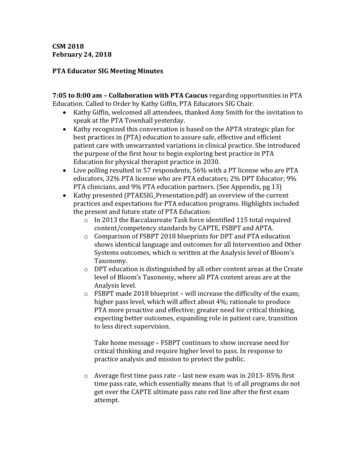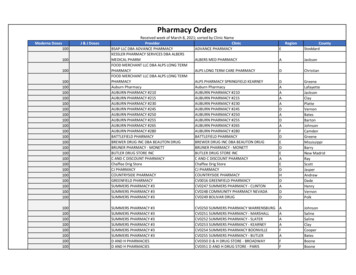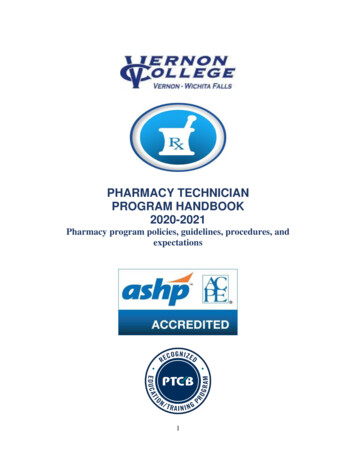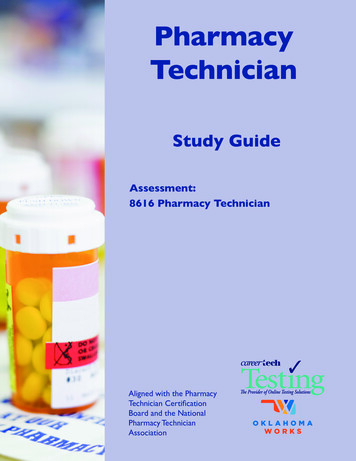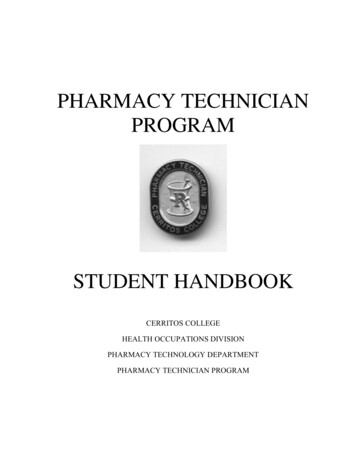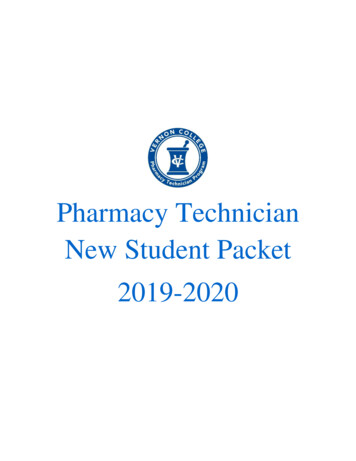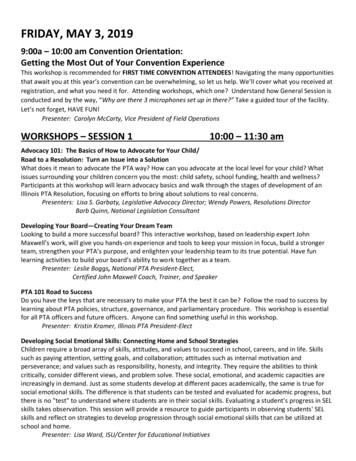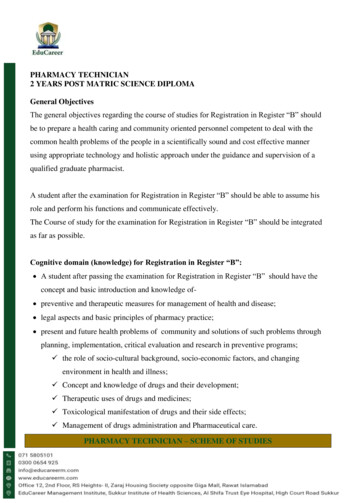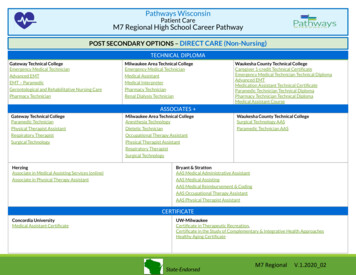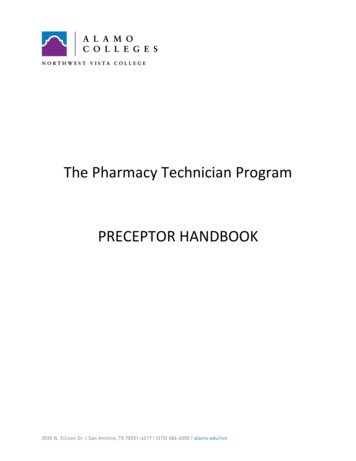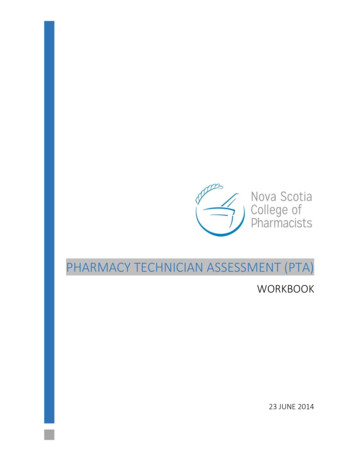
Transcription
PHARMACY TECHNICIAN ASSESSMENT (PTA)WORKBOOK23 JUNE 2014
Nova Scotia College of PharmacistsPharmacy Technician Assessment Workbook23June 2014TABLE OF CONTENTS1. Introduction . 22. Program ActivitiesExercise #1: Documentation of Drug Distribution Processes . 5Exercise #2: Verbal Prescriptions and Prescription Transfers . 7Exercise #3: Technical Check . 9Exercise #4: Product Release . 11Exercise #5: Professional Collaboration . 13Exercise #6: Communication and Education . 153. AppendicesAppendix A: Instructions for Checking the Accuracy and Quality of the Final Product . 17Appendix B: Prescription Daily Tracking Log . 21NSCP CONTACT INFORMATIONNova Scotia College of Pharmacists1559 Brunswick Street, Suite 200Halifax, NS B3J 2G1Fax: 902.422.0885Melissa RhodesManager of Registrationsmrhodes@nspharmacists.ca902.422.8528 Ext 1Sue SampsonProject Director/Lead Pharmacy Technician Regulationssampson@nspharmacists.ca902.422.8528 Ext 8Page 1
Nova Scotia College of PharmacistsPharmacy Technician Assessment Workbook23June 20141. INTRODUCTIONOne of the qualifications for registration and licensing as a pharmacy technician with the Nova ScotiaCollege of Pharmacists (NSCP) is “successful completion of an assessment of the applicant's basiccompetencies in a direct patient care practice setting approved by the Council” 1. The PharmacyTechnician Assessment (PTA) is a competency assessment of a technician candidate performed in theworkplace by an approved licensed pharmacy technician or pharmacist preceptor.The pharmacy technician candidate will complete activities that fall within the registered pharmacytechnician’s scope of practice in Nova Scotia and are based on competencies set forth in the NAPRAProfessional Competencies for Canadian Pharmacy Technicians at Entry to Practice (2014)2. Thepharmacy technician candidate is required to complete all activities and/or demonstrate the skill(s) to thesatisfaction of the preceptor, regardless of the practice setting where completion of the PTA is takingplace.RELEVANT COMPETENCIESCompetency 1: Ethical, Legal, and Professional Responsibilities1.5Document activities of practice in compliance with federal and provincial/territoriallegislation, standards, and policies.1.5.1 Maintain complete, accurate and secure patient records.Competency 3: Product Distribution3.1Receive, interpret and process a prescription.3.1.1 Transcribe verbal orders and ensure their accuracy.3.1.2 Transfer a prescription and receive a transferred prescription.3.4Verify the technical aspects of the prescription to ensure accuracy and quality ofproducts.3.4.1 Identify when an independent double check should be performed.3.4.2 Check the product and its prescription label against the prescription using a systematicapproach.3.5Collaborate with the pharmacist in the release of the product.3.5.1 Determine whether the legal and professional requirements for a product to be released tothe patient have been met.3.5.2 Identify when the patient requires further consultation or education from the pharmacist.12NSCP Registration, Licensing & Professional Accountability Regulations s.8(1)(f)http://napra.ca/Content Files/Files/Comp for Cdn PHARMTECHS at EntrytoPractice March2014.pdfPage 2
Nova Scotia College of PharmacistsPharmacy Technician Assessment Workbook23June 2014Competency 7: Communication and Education7.1Establish and maintain effective communication.7.1.1 Demonstrate proficiency in written and verbal English or French.7.1.2 Demonstrate appropriate verbal and non-verbal communication skills, including listeningskills.7.1.4 Select appropriate communication and education techniques for use with the patient andother health professionals.7.1.5 Conduct interpersonal interactions, including conflict management, in a professionalmanner.7.1.6 Communicate with sensitivity, respect and empathy.7.2Use safe, effective and consistent communication systems.7.2.1 Use communication techniques that maximize safety and understanding, includingrepeating back verbal orders, using recognized terminology and avoiding unnecessary or unsafeabbreviations.7.2.2 Record and store information in a consistent manner for efficient access and retrieval byrelevant personnel.7.2.3 Select appropriate technology to facilitate communication.Competency 8: Intra and Inter-Professional Collaboration8.1Create and maintain collaborative professional relationships.8.1.1 Create and maintain collaborative professional relationships.8.1.2 Contribute to the effectiveness of working relationships in collaborative teams.8.2Contribute to the effectiveness of working relationships in collaborative teams.8.2.1 Interact respectability with other members of the team by accepting accountability forthemselves and managing disagreements and conflict.Important:PTA participants cannot perform any of the activities alone since they are not yet licensed to doso. Pharmacy technician candidates must clearly identify themselves as such during allprofessional interactions and must always be under the direct supervision of a licensed registrantof the NSCP.Page 3
Nova Scotia College of PharmacistsPharmacy Technician Assessment Workbook23June 2014BEFORE YOU BEGIN THE PTABoth the pharmacy technician candidate and the preceptor must review the PTA Workbooksupplementary document Pharmacy Technician Assessment (PTA) Program Information for PharmacyTechnician Candidates and Preceptors prior to beginning the program. This document contains importantinformation, including: PTA goalsPrerequisitesApplication submissionPreceptor eligibility and responsibilitiesPharmacy technician candidate responsibilitiesSite criteriaConflict of Interest considerationsCompetency assessment and gradingLength of PTACompletion of PTA and submission of final documentsHOW TO COMPLETE THIS WORKBOOKThe workbook consists of a six exercises, each containing one or two related activities that must becompleted by the pharmacy technician candidate. The exercises and activities may be completed in anorder.In completing the various activities, the pharmacy technician must include relevant notes, observations,summaries and answers to specific questions included as part of the activity. The preceptor is expectedto review these notes for completeness.For each exercise, the preceptor must provide an assessment of the pharmacy technician s ability tocomplete the activities and/or demonstrate the targeted skill(s). Once this has been done to thesatisfaction of the preceptor, he or she signs and dates the associated exercise page in the workbook,including any relevant comments or observations.COMPLETION OF THE PTAOnce all exercises and associated activities have been completed to the preceptor s satisfaction, the PTADeclaration of Completion must be completed and signed by both the pharmacy technician candidate andpreceptor and submitted to the NSCP within ten days of completion of the PTA.The preceptor is asked to complete and submit the PTA Preceptor Program Evaluation.The pharmacy technician candidate must submit the completed PTA Workbook, all Prescription DailyTracking Logs, and the PTA Pharmacy Technician Candidate Program Evaluation to the NSCP within tendays of completion of the PTA.Page 4
Nova Scotia College of PharmacistsPharmacy Technician Assessment Workbook23June 20142. PROGRAM ACTIVITIESEXERCISE 1: DOCUMENTATION OF DRUG DISTRIBUTION PROCESSESActivitiesFor accountability purposes, it is important that the various aspects of the drug distribution process arewell documented. It must be clear who has taken the responsibility for what aspect of the drugdistribution process including: receiving a (verbal) prescription, entering the prescription into thepharmacy computer system, preparing the prescription (including all steps involved in compliance orunit dose packaging), assessing the prescription for therapeutic appropriateness, verification of thetechnical accuracy of the completed prescription, patient counselling, and any follow up monitoringactivities.1. Note how documentation at your practice site is auditable and traceable for the various aspects ofdrug distribution. Could any changes be made to improve the process?2.Summarize your findings.Preceptor Comments and Assessment (use back of page if needed)I confirm that the candidate has completed the above activities and/or demonstrated the skill(s)to my satisfaction.Date:Preceptor s signature:Suggested ResourcesNAPRA Model Standards of Practice for Canadian Pharmacy TechniciansNSCP Pharmacy Practice RegulationsNSCP Standards of Practice: General Practice (Pharmacists)Relevant Competencies1.5Page 5
Nova Scotia College of PharmacistsPharmacy Technician Assessment Workbook23June 2014EXERCISE 1: DOCUMENTATION OF DRUG DISTRIBUTION PROCESSESCANDIDATE NOTES / DOCUMENTATIONPage 6
Nova Scotia College of PharmacistsPharmacy Technician Assessment Workbook23June 2014EXERCISE 2: VERBAL PRESCRIPTIONS AND PRESCRIPTION TRANSFERSActivities11. Receive and accurately transcribe at least two verbal orders from a prescriber, making sure torecord all information as required by legislation. Use communication techniques that maximizesafety and understanding, including repeating back information to the prescriber, using recognizedterminology and avoiding unnecessary abbreviations.2. Under the supervision of your preceptor, receive from a pharmacy or transfer to another pharmacya total of five verbal or faxed prescriptions.a. Summarize your experience with each of the transfers.b. Were any issues encountered during the process and how were they be addressed?c. Can a pharmacy refuse to transfer a prescription?d. What are the legal requirements for transferring a prescription?Preceptor Comments and Assessment (use back of page if needed)I confirm that the candidate has completed the above activities and/or demonstrated the skill(s)to my satisfaction.Date:Preceptor s Signature:Suggested ResourcesCanada’s Food and Drug RegulationsNSCP Pharmacy Practice RegulationsNSCP Transfer of Prescriptions PolicyNAPRA Professional Competencies for Canadian Pharmacy Technicians at Entry to PracticeNAPRA Model Standards of Practice for Canadian Pharmacy TechniciansRelevant Competencies3.1, 7.1, 7.21If the technology or site poses restrictions on these activities, the preceptor could use other strategies (e.g. rollplay).Page 7
Nova Scotia College of PharmacistsPharmacy Technician Assessment Workbook23June 2014EXERCISE 2: VERBAL PRESCRIPTIONS AND PRESCRIPTION TRANSFERCANDIDATE NOTES / DOCUMENTATIONPage 8
Nova Scotia College of PharmacistsPharmacy Technician Assessment Workbook23June 2014EXERCISE 3: TECHNICAL CHECKImportant: Before beginning this activity, the pharmacy technician candidate and the preceptormust review Instructions for Checking Accuracy and Quality of Final Product (Appendix B)Activities1. The pharmacy technician candidate must demonstrate competency in his or her ability toaccurately perform a check of the technical accuracy of completed prescriptions/orders preparedfor release to patients, under normal working conditions. In order to meet this competency, thecandidate must accurately perform 500 technical checks in a row without making an error. Thecandidate must record ALL checked prescriptions (including those where an error is made) on thePTA Prescription Daily Tracking Log (Appendix C). A maximum of 50 prescription checks will be counted in any one day.A new tracking log must be used each day to record prescriptions checked and any errorsidentified.No errors are permitted during the technical checking process. If an error occurs, thepreceptor must inform the participant and discuss the error made. The checking process mustthen be reset to zero, regardless of how many of the targeted 500 consecutive checks havebeen completed.All prescriptions checked by the pharmacy technician candidate must be secondchecked by the preceptor or delegate (other pharmacist or registered pharmacytechnician) for technical accuracy.Remember that no product can be released to the patient until the pharmacist hasassessed the appropriateness of therapyPreceptor Comments and Assessment (use back of page if needed)I confirm that the candidate has completed the above activities and/or demonstrated the skill(s)to my satisfaction.Date:Preceptor s Signature:Suggested ResourcesPTA Instructions for Checking Accuracy and Quality of Final Product (Appendix A)PTA Prescription Daily Tracking Log (Appendix B)NSCP Prescription Labels PolicyNAPRA Model Standards of Practice for Canadian Pharmacy TechniciansRelevant Competencies3.4Page 9
Nova Scotia College of PharmacistsPharmacy Technician Assessment Workbook23June 2014EXERCISE 3: TECHNICAL CHECKCANDIDATE NOTES / DOCUMENTATIONPage 10
Nova Scotia College of PharmacistsPharmacy Technician Assessment Workbook23June 2014EXERCISE 4: PRODUCT RELEASEActivities1. Discuss the following with your preceptor:a. What does the legislation state with respect to the responsibility of the pharmacist to: Ensure the appropriateness of therapy? Counsel the patient? Monitoring the initial and ongoing appropriateness of a patient’s drug therapy?b. What processes are in place at the practice site to confirm that the pharmacist has reviewedthe prescription and patient record to determine appropriateness of therapy and that therequirements for counselling as set out in the Pharmacy Practice Regulations have been met?c. What processes are in place to ensure that the prescriptions are released to the correctcustomer or agent?2. Summarize your findings.Preceptor Comments and Assessment (use back of page if needed)I confirm that the candidate has completed the above activities and/or demonstrated the skill(s)to my satisfaction.Date:Preceptor s Signature:Suggested ResourcesNSCP Pharmacy Practice RegulationsNSCP Releasing Medications to Patients and their Agents PolicyNAPRA Model Standards of Practice for Canadian Pharmacy TechniciansNSCP Standards of Practice: General Practice (Pharmacists)Relevant Competencies3.5Page 11
Nova Scotia College of PharmacistsPharmacy Technician Assessment Workbook23June 2014EXERCISE 4: PRODUCT RELEASECANDIDATE NOTES / DOCUMENTATIONPage 12
Nova Scotia College of PharmacistsPharmacy Technician Assessment Workbook23June 2014EXERCISE 5: PROFESSIONAL COLLABORATIONActivities1. Reflect on a positive situation that occurred in your workplace when the relationship between youand another health care professional was collaborative. What effective communication skills weredemonstrated?2. Reflect on a situation where the interaction was not ideal between you and a patient or other healthcare provider and consider:a. What may have contributed to the situation?b. What changes could have been made or issues addressed that may have resulted in a betterinteraction?Preceptor Comments and Assessment (use back of page if needed)I confirm that the candidate has completed the above activities and/or demonstrated the skill(s)to my satisfaction.Date:Preceptor s Signature:Suggested ResourcesNAPRA Professional Competencies for Canadian Pharmacy Technicians at Entry to PracticeNAPRA Model Standards of Practice for Canadian Pharmacy TechniciansRelevant Competencies8.1, 8.2Page 13
Nova Scotia College of PharmacistsPharmacy Technician Assessment Workbook23June 2014EXERCISE 5: PROFESSIONAL COLLABORATIONCANDIDATE NOTES / DOCUMENTATIONPage 14
Nova Scotia College of PharmacistsPharmacy Technician Assessment Workbook23June 2014EXERCISE 6: COMMUNICATION AND EDUCATIONActivities1. Prepare and deliver a 5-10 minute presentation to your preceptor, staff, or other group that helps topromote understanding of the role of the registered pharmacy technician and its relationship to theroles of other health care providers. Consider including information such as requirements tobecome a registered pharmacy technician, scope of practice, how the role of the pharmacytechnician complements and supports the pharmacist’s role, etc.2. Demonstrate the proper use of a device (to be chosen by your preceptor) to a patient, staff, or yourpreceptor. What special advice or precautions specific to the device should be mentioned duringthis demonstration?Preceptor Comments and Assessment (use back of page if needed)I confirm that the candidate has completed the above activities and/or demonstrated the skill(s)to my satisfaction.Date:Preceptor s Signature:Suggested ResourcesNAPRA Model Standards of Practice for Canadian Pharmacy TechniciansRelevant Competencies7.1, 7.2Page 15
Nova Scotia College of PharmacistsPharmacy Technician Assessment Workbook23June 2014EXERCISE 6: COMMUNICATION AND EDUCATIONCANDIDATE NOTES / DOCUMENTATIONPage 16
Nova Scotia College of PharmacistsPharmacy Technician Assessment Workbook23June 20143. APPENDICESAPPENDIX A: INSTRUCTIONS FOR CHECKING ACCURACY AND QUALITY OFTHE FINAL PRODUCT1.Pharmacy technician candidate orientation and reviewPrior to beginning this exercise, the preceptor must have a conversation with the pharmacy techniciancandidate to highlight the expectations of the candidate with respect to the checking process.There should be a clear understanding between the preceptor and candidate regarding:a. What are considered prescriptions or products.b. What will be considered to be an error in the filling process (and therefore reportable as anerror).c. The procedure that will be followed in the event that the candidate misses identifying an errormade in the filling process.2.ActivityThis activity assesses the pharmacy technician candidate’s competency in accurately performing thetechnical check of products or prescriptions prepared for release to a patient. Best practice forchecking the technical accuracy of prepared prescriptions is an independent double check 1, howeversituations may arise in practice whereby this may not be possible or practical; and in such situationsall technical aspects of filling a prescription, including entering the prescription into the pharmacysoftware, selection of drug from stock, and technical check may be performed by the pharmacytechnician. This assessment allows for the pharmacy technician to check products or prescriptionsprepared under both set of circumstances.If another pharmacy team member has played a role in the preparation of the product or prescription,it is important that this team member does not communicate what he or she expects the pharmacytechnician to see, which would create bias and reduce the visibility of a potential error.To address this competency, pharmacy technician candidates must accurately perform a total of 500consecutive technical checks of prepared products or prescriptions under the following conditions:a. Normal working conditionsb. A maximum of 50 prescriptions/orders per dayc.A full complement of the various types of prescriptions/products should be checked, includingnew and repeat prescriptions, compounds, sterile preparations (if applicable), different typesof unit dose packages, cards and dosettes.d. NO ERRORS are permitted during the checking process. IF AN ERROR OCCURS, thepreceptor must inform the participant and discuss the error made. The checking processmust then be reset to zero, regardless of how many of the targeted 500 consecutive checkshave been completed.e. The checking process is considered complete once the applicant has accurately performed500 consecutive checks.1For definition, see the Institute for Safe Medication Practices (ISMP) Canada www.ismp-canada.org/definitions.htmPage 17
Nova Scotia College of PharmacistsPharmacy Technician Assessment Workbook23June 2014All items checked by the pharmacy technician candidate must be second checked by thepreceptor or preceptor’s delegate (other pharmacist or licensed pharmacy technician) fortechnical accuracy.No product can be released to the patient until the pharmacist has assessed theappropriateness of therapy.3.Prescription Daily Tracking Loga. The purpose of the Daily Tracking Log is to:i.record/track the checking that has been completed.ii.help document any errors caught or made during the checking process.b. Procedure for filling out the Daily Tracking Log:i.The candidate must start a new log sheet each day to record all checked prescriptions andany identified errors.ii.The candidate must record all relevant information on the log: Date and name Prescription number or type of items checked Any errors identified or “no error” if none are found Initials once the check has been completediii. The preceptor must also check the item checked by the pharmacy technician and: Initial “no error missed” if: there is no error in the prescription and this has been appropriately identifiedby the pharmacy technician candidate; or there is an error in the prescription but this has been appropriately identifiedby the pharmacy technician Initial “error missed” if: there is an error in the prescription but it is NOT appropriately identified bythe pharmacy technician candidate Records the type of error missed by the pharmacy technician candidate if applicable.4.The Technical Checking Processa. When checking the dispensed medication, the label and medication should always be checkedagainst the prescription. The order in which these checks are carried out may vary but all of thefollowing checks need to be performed:i.Right patientii. Right drug, dosage form, and routeiii. Right dose and quantityiv. Right directionsv. Right doctorvi. Additional considerationsPage 18
Nova Scotia College of PharmacistsPharmacy Technician Assessment Workbook23June 2014b. The following process may be used as a reference for checking community and/or hospitalprescriptions, orders, vials, compounds, unit dose bins, blister packing and other compliancepackaging, or other similar processes.1 All steps may not be applicable to all settings.i.Right patient Check the patient’s name on the prescription/order and vial/product label foraccuracy. Be extra vigilant when there are duplicate names in the pharmacycomputer system. Check patient’s address and/or date of birth especially when multiple patients havethe same name. (Hospital) Check that the bin/card/product item, etc. has been labeled with the correctpatient name, room number, and floor.iii. Right drug, dosage form, and route Check to ensure that the drug name on the prescription/order matches that on thevial/product label (with allowance for generic substitution). Pay particular attention tochecking drugs ordered that have a name that is similar to another medicine toensure that the correct drug is dispensed. Refer to Nova Scotia Formulary or hospital formulary to determine if a generic drug isavailable. (Hospital) Follow automatic substitution policies as applicable. Match the DIN (Drug Identification Number) on the hard copy to the manufacturerbottle label/product. Check that the dosage form matches that stated on the prescription. Check the physical appearance of the drug to ensure that the product in thevial/package is what the label states. Ensure integrity of final product. Check the expiration date on the manufacturer’s stock bottle/product to ensure that itis sufficient for the treatment period. Take extra care with liquids which may have ashorter shelf life once the stock bottle has been opened.iv. Right dose and quantity Check the strength of the medication to ensure that the strength on the prescriptionhas been interpreted correctly. Check calculations for dosage, compounding, etc. Check the quantity on the prescription and vial label to ensure they are the same. Ifthe quantity has been calculated from information on the prescription, double checkthe calculation. Check the number of refills on the prescription and vial/product label to ensure theyare the same. (Hospital) Ensure the product has been correctly selected and placed into the correctbin/card/bag/etc.1The pharmacy technician candidate and preceptor may need to adapt the checking process to be workplace specific wherenecessary.Page 19
Nova Scotia College of PharmacistsPharmacy Technician Assessment Workbook23June 2014 Quantity of the product item matches the quantity on the pick list/MAR/labelor other form of checking list. Placed into the bin in order of administration times with regularly scheduledmedications in the front and prn orders in the back.v. Right directions Verify that the directions on the prescription are the same as what is stated on thevial/product label. Ensure that the directions are clear and easy to understand.vi. Right doctor Check the prescriber’s name on the prescription and vial/product label to ensure allinformation is correct. Consider prescribing laws and regulations.vii. Container/Packaging and Additional Considerations Check that the most appropriate packaging/container has been used. Consideration should be given to any auxiliary information/labels necessary forappropriate care (may be site specific). Prescriptions/orders need to be checked that they are in compliance with allregulations and policies regarding the dispensing of drugs. The candidate must ensure that all documentation has been completed and filed.Page 20
Nova Scotia College of PharmacistsPharmacy Technician Assessment Workbook23June 2014Page 21
Nova Scotia College of PharmacistsPharmacy Technician Assessment Workbook23June 2014Page 22
Nova Scotia College of PharmacistsPharmacy Technician Assessment Workbook23June 2014NOTESPage 23
In completing the various activities, the pharmacy technician must include relevant notes, observations, summaries and answers to specific questions included as part of the activity. The preceptor is expected to review these notes for completeness. For each exercise, the preceptor must provide an assessment of the pharmacy technician s ability to
